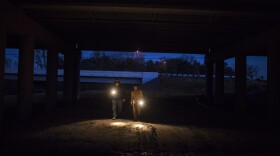Long-time Austinites might remember Homer the Homeless Goose, who rose to local and even national fame in the late 1980s as a champion for the rights of the homeless community. Homer served as the mascot for Austin’s unhoused population. He passed away last month at the age of 27 (a pretty long life for a goose – over 100 in goose years, according to Austin Zoo officials).
“Austin’s homeless mascot for 27 years took a forever flight…Folks that hear about him for the first time will wish that they could have met Ole Homer,” Fred Pettit wrote in The Challenger, a newspaper written and distributed by Austin's homeless.
A memorial will be held for Homer this weekend.
Homeless advocate Peter Cooper shares a birthday with Homer on April 1. Each year, the homeless and advocate community would throw a birthday party for Homer – and Peter – at the zoo. Homer, who lived with activist Lori Renteria for 18 years, moved to the Austin Zoo & Animal Sanctuary in 2006.
Valerie Romness, director and editor of The Challenger, has been an advocate for years, and she remembers how, even after his brush with fame in the late '80s (he met Willie Nelson), Homer remained a part of the homeless and activist community.
“As I became an advocate in the '90s, I knew Homer…and so if ever in the homeless community there was not enough help I would sometimes say, ‘You know, I know where Homer lives, and I can go get him.’ And Homer would come out on events, show his support, and he was very socialized,” Romness says.
In the video below, shot by Romness, Homer is reunited with a man called Cadillac after nearly 20 years. According to Cooper, Cadillac helped rescue Homer from the lake in the late '80s after a storm.
If a goose seems an unlikely mascot for the homeless community – Cooper says that they didn’t even want Homer initially. They wanted a swan.
“So at the time, [homeless and advocates] wanted to utilize the tension between ‘people-people’ and ‘animal-people,’” he says, to draw attention to the needs of Austin’s homeless.
The group gave up on its initial idea – to steal a swan off Lady Bird Lake – and decided that instead of stumbling into the legal minefield of bird theft, they’d buy a swan instead.
They pooled their money and went to Callahan’s General Store to buy a swan, but they only had about seventeen dollars. It was enough for a gosling, and they named him Homer. For a while, says Pettit, the goose lived with two people on rafts on Lady Bird Lake, which was legal to do at the time.
But, part of the initial strategy with Homer was a little dark. The homeless community threatened publicly to kill and eat Homer if their demands for more services weren’t met. They didn’t kill him, obviously, and the stunt gained them some attention from the community, and the country, particularly from animal rights activists.
The homeless community was able to use the attention to make some demands. Eventually, Homer was even credited with helping to convince the city to help establish the HOBO (Helping Our Brothers Out) day shelter, says Romness.
Though his fame waned — he basically retired after the '80s — Homer remained a symbol and a friend to homeless people and advocates. His list of demands became a tradition. Each year, Homer’s birthday was an occasion to remind the city that the homeless were in need of support. Today, activists and organizers use the birthday to argue not only for more shelters, but for housing first options that would lift the barriers of sobriety and employment to provide immediate housing for those without.
Homer had been living in the Austin Zoo for years, and last year he beat cancer. He was a favorite among zoo staff members, says zoo director Patty Clark, and was treated to private swims each morning and afternoon in a little pool behind the gift shop. He loved people, she says.
His death on March 15 was from old age, they say, and it wasn’t totally unexpected. As per the plans set in place by advocates years ago, Homer is now being taxidermied – stuffed – so he can live on as a representation of homeless rights. The stuffing process will take about two and a half months.
Cooper says he thinks stuffed Homer will live at the Austin History Center, and he’ll be available to be “checked out” – for conferences, marches and rallies.
This weekend, instead of having a birthday party for Homer as they’d planned, advocates are having a memorial in his honor at Auditorium Shores at 3 p.m. near the House the Homeless Memorial Tree & Plaque. Anyone with memories of Homer, or experiences living homeless in Austin, is invited to come share their memories.



